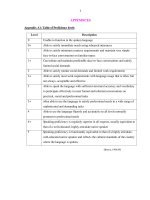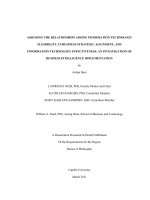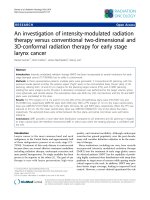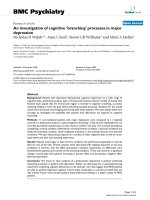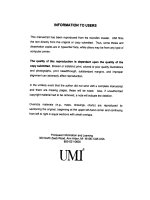an investigation of accuracy, learning and biases in judgmental adjustments of statistical forecasts
Bạn đang xem bản rút gọn của tài liệu. Xem và tải ngay bản đầy đủ của tài liệu tại đây (4.27 MB, 333 trang )
AN INVESTIGATION OF ACCURACY, LEARNING AND BIASES
IN JUDGMENTAL ADJUSTMENTS OF STATISTICAL FORECASTS
DISSERTATION
Presented in Partial Fulfillment of the Requirements for
the Degree of Doctor of Philosophy
In the Graduate School of The Ohio State University
By
Cuneyt Eroglu
* * * * *
The Ohio State University
2006
Dissertation Committee:
Approved by
Professor Douglas M. Lambert, Adviser
Professor Keely L. Croxton
_____________________________
Professor A. Michael Knemeyer Adviser
Graduate Program in
Business Administration
Copyright by
Cuneyt Eroglu
2006
ii
ABSTRACT
Judgmentally adjusting a statistical forecast before using it is a widespread
practice in business. The goal of this study is to provide a deeper understanding of
judgmental adjustments of statistical forecasts to improve forecasting performance. The
forecasting performance is measured with three dependent variables. The first dependent
variable is accuracy improvement which represents the positive change in forecast
accuracy after a judgmental adjustment. The second dependent variable is learning which
refers to the continuous improvement of a forecaster’s performance over time. The third
variable is actually a set of variables that includes various biases. A bias is a systematic
deviation in forecasts that is introduced by a particular forecaster. The independent
variables included in this study are personality variables, motivational variables and
situational variables. Personality is measured by the Big-Five model that analyzes an
individual’s personality in five dimensions including extraversion, conscientiousness,
neuroticism, agreeableness and openness to experience. Motivational variables are
measured in terms of motivational orientation and various motivational stimuli.
Situational variables include feedback, supervision, timing of adjustment, and
demographics.
iii
Data were collected from a company where store managers used judgmental
adjustments of statistical forecasts to improve the forecast accuracy for their stores. The
data collection covered a period of 12 months and 390 stores over several Midwestern
and southeastern states. The data for dependent variables were obtained from forecasting
records and the data for independent variables were collected using a survey instrument.
The results indicate that, on average, judgmental adjustments of statistical
forecasts result in accuracy improvement. The extent of the accuracy improvement is
affected by personality, motivational and situational variables. Furthermore, there was
evidence for biases that were introduced through judgmental adjustments. Biases were
also moderated by personality, motivational and situational variables. This study detected
no evidence of learning.
iv
ACKNOWLEDGMENTS
A doctoral dissertation is rarely an exclusive work of a single individual. This
dissertation is no exception. I am deeply indebted to several people whose support, help
and encouragement made this dissertation a reality. Their contributions to this study were
invaluable.
First and foremost, I would like to thank Professor Douglas M. Lambert, Director
of The Global Supply Chain Forum at The Ohio State University and Chairman of my
dissertation committee. He has been very supportive throughout the entire course of my
doctoral program in countless ways. His expert judgment and constructive critiquing of
my work enabled me to navigate safely and productively through every phase of my
dissertation from selecting a promising research topic to applying rigorous academic
standards to my data collection and analysis to communicating the research results in a
well-written dissertation. He not only guided me from an academic perspective, but also
helped me obtain business data for my dissertation and make my research relevant to
practitioners. His insights, feedback, encouragement and guidance have made this
dissertation remarkably better. Above all, he has provided me with an excellent role
model as a researcher, a teacher and an academician, which I will always look up to and
which will surely shape my academic career for the years to come.
v
Together with Professor Lambert, Professor Keely L. Croxton and Professor A.
Michael Knemeyer formed my dissertation committee that guided me through the
dissertation phase of my studies. Their feedback and insights contributed immensely to
the quality of the end product. They were always ready and willing to assist me with any
challenges and dilemmas that I was facing. Furthermore, they dedicated many hours of
their time to review my work and provide me with further guidance. I will forever owe
Professor Croxton and Professor Knemeyer a debt of gratitude.
I also would like to thank Professor Martha C. Cooper, Professor Walter Zinn and
Professor Thomas J. Goldsby who have made significant contributions to my personal
and professional growth during my Ph.D. program. During my interactions with them,
both inside and outside the class room, our discussions have always been intellectually
stimulating and broadened my horizons. Their support and guidance will forever be
remembered with much gratefulness.
As a person who has always gone beyond the call of duty, Shirley J. Gaddis
deserves much credit. Without her crucial assistance and extraordinary organizational
skills, it would have been much more difficult for me to communicate with my
dissertation committee members, schedule meetings and presentations, and circulate
drafts of my work. She has been an exceptional facilitator between my dissertation
committee members and myself, which, in turn, substantially shortened the time required
for writing this dissertation.
I would also like to express my gratitude for my fellow doctoral students who
have helped create a friendly working atmosphere where we shared good times, debated
research ideas, and vented during more challenging times. Furthermore, I have received
vi
much help from the staff at the Marketing and Logistics Department, the Graduate
Programs Office and the Office of International Education. Their assistance is greatly
appreciated.
This dissertation is based on the data obtained from a company that is a member
of The Global Supply Chain Forum at The Ohio State University. I would like to express
my deepest thanks to the executives at this company and other member companies of The
Global Supply Chain Forum who have provided me with data, stimulated my thinking
with their questions, and enriched my work with their suggestions and feedback. Their
contributions added immensely to the value of this dissertation. I shall forever be grateful
to them.
Last but not least, I would like to thank Steven Robeano, a dear friend who has
always been there for me throughout the Ph.D. program. I could always count on him to
listen to me, to share his insights and ideas, to offer advice and provide encouragement.
His friendship is greatly appreciated.
vii
VITA
EDUCATION
1992 Bachelor of Science, Industrial Engineering, Middle East
Technical University, Ankara, Turkey
1994 Master of Science, Management Science, University of
Miami, Coral Gables, Florida
2004 Master of Arts, Business Administration, Logistics, Fisher
College of Business, The Ohio State University
2002-present Graduate Teaching and Research Associate, The Ohio State
University
PROFESSIONAL EXPERIENCE
1994-1996 Logistics Analyst, Ryder Dedicated Logistics, Miami,
Florida
1997-1998 Analyst, Istanbul Gold Exchange, Istanbul, Turkey
1999-2001 Business Development Manager, Federal Express, Istanbul,
Turkey
2001-2001 Project Manager, Ericsson Telecommunications, Istanbul,
Turkey
viii
FIELDS OF STUDY
Major Field: Business Administration
Areas of Specialization: Logistics and Marketing
ix
TABLE OF CONTENTS
ABSTRACT ii
ACKNOWLEDGMENTS iv
VITA vii
LIST OF TABLES xiii
LIST OF FIGURES xviii
CHAPTER 1 INTRODUCTION 1
1.1 Background 1
1.1.1 Theoretical Background 4
1.1.2 Business Background 7
1.2 Research Design 9
1.2.1 Research Purpose 10
1.2.2 Model Building and Hypotheses 11
1.2.3. Data Collection and Analysis 15
1.3 Limitations 16
1.4 Potential Contributions 19
1.4.1 Managerial Contributions 19
1.4.2 Academic Contributions 20
1.5 Organization 21
LIST OF REFERENCES 23
CHAPTER 2 LITERATURE REVIEW 25
2.1 Prevalence of Judgmental Adjustments 26
2.2 Efficacy of Judgmental Adjustments 27
2.2.1 The Case Against Judgmental Adjustments 28
2.2.2 The Case for Judgmental Adjustments 33
2.2.3 Domain Knowledge and Judgmental Adjustments 36
2.3 Factors Affecting the Accuracy of Judgmental Adjustments 38
2.4 A Critique of Current Literature 51
x
2.5 Summary 55
LIST OF REFERENCES 57
CHAPTER 3 MODEL BUILDING AND HYPOTHESES 61
3.1 The Working Model 61
3.1.1 Brunswik’s Lens Model 62
3.1.1.1 Functionalism 65
3.1.1.2 Probabilism 66
3.1.2 Hogarth’s Model 68
3.1.3 Information-Processing Model 72
3.1.4 Work Performance Model 76
3.1.5 Synthesis of Relevant Characteristics of the Above Models 79
3.1.6 The Working Model 81
3.2 The Dependent Variables 85
3.2.1 Accuracy Improvement 85
3.2.2 Learning 87
3.2.3 Biases 88
3.3 Independent Variables 92
3.4 Hypotheses 94
3.4.1 Intelligence 95
3.4.2 Personality 95
3.4.2.1 The Big-Five Personality Model 97
3.4.2.2 Conscientiousness 98
3.4.2.3 Emotional Stability 99
3.4.2.4 Extraversion 101
3.4.2.5 Agreeableness 102
3.4.2.6 Openness to Experience 102
3.4.3 Motivation 103
3.4.3.1 Motivational Orientation 107
3.4.3.2 Motivation-Behavior-Performance Connection 110
3.4.3.3 Motivational Behaviors 114
3.4.3.4 Motivational Stimuli 117
3.4.4 Situational Variables 124
3.4.4.1 Directional Bias 125
3.4.4.2 Information Sharing 126
3.4.4.3 Feedback 127
3.4.4.4 Presentation of information 127
3.4.4.5 Presentation of adjustment 129
3.4.4.6 Timing of adjustment 129
3.4.4.7 Experience 129
3.4.4.8 Demographics 130
3.4.4.9 Data variability 130
3.4.4.10 Sales Volume 131
xi
3.5 Summary 131
LIST OF REFERENCES 132
CHAPTER 4 METHODOLOGY 140
4.1 Research Design 141
4.1.1 A Critical Overview of Laboratory Experiments 142
4.1.2 A Critical Overview of Field Studies 148
4.1.3 Design of Current Research Study 151
4.2 Research Setting 154
4.3 Data Collection 159
4.3.1 Adjustment Data 160
4.3.2 Survey Instrument 162
4.3.2.1 General Considerations and Cover Page 162
4.3.2.2 Personality 164
4.3.2.3 Work Locus of Control 168
4.3.2.4 Scale for Motivation 169
4.3.2.5 Forecasting Practices and Demographics 173
4.3.2.6 Determination of Sample Size 177
4.4 Summary 179
LIST OF REFERENCES 180
CHAPTER 5 DATA ANALYSIS AND RESULTS 183
5.1 Description of Input Data 183
5.1.1 Demand Data 184
5.1.2 Adjustments Data 189
5.1.3 Survey Responses 193
5.2 Description of Outcome Variables 197
5.2.1 Accuracy Improvement 198
5.2.2 Learning 202
5.2.3 Biases 203
5.2.4 Testing for Non-Response Bias 210
5.3 Hypotheses Testing 212
5.3.1 Personality 213
5.3.2 Motivation 220
5.3.2.1 Motivational Orientation 220
5.3.2.2 Motivational Behaviors and Stimuli 227
5.3.3 Situational Variables 244
5.3.3.1 Directional Bias 244
5.3.3.2 Information Sharing 245
5.3.3.3 Feedback 246
5.3.3.4 Presentation of information and presentation of adjustments 250
5.3.3.5 Timing of adjustment 252
xii
5.3.3.6 Experience 255
5.3.3.7 Demographics 257
5.3.3.8 Data variability 260
5.3.3.9 Sales Volume 261
5.4 Summary 263
LIST OF REFERENCES 265
CHAPTER 6 SUMMARY AND CONCLUSIONS 266
6.1 Motivation for the Present Study 266
6.2 Research Setting 267
6.3 Summary of Results 268
6.3.1 Accuracy Improvement, Learning and Biases 268
6.3.2 Personality Variables 270
6.3.3 Motivational Variables 272
6.3.4 Situational Variables 275
6.4 Managerial Implications 277
6.4.1 Personnel Selection 277
6.4.2 Training 278
6.4.3 Task Design 279
6.5 Future Research Opportunities 280
6.6 Summary 282
BIBLIOGRAPHY 284
APPENDIX A THE SURVEY INSTRUMENT 297
APPENDIX B THE SELECTION OF CUTOFF POINT 302
APPENDIX C SCALE ASSESSMENT 307
xiii
LIST OF TABLES
Table 1: Characteristics of the judgmental adjustment at the research company 16
Table 2: Information provided to experimental groups 42
Table 3: Components of skill addressed by selected methods for improving forecasts 50
Table 4: Summary of studies reviewed in this chapter 52
Table 5: A forecast with n half-hour time intervals 86
Table 6: Accuracy improvement formulas 87
Table 7: Meta-analytic results (true validities) 96
Table 8: Strengths and weaknesses of lab experiments and field studies 141
Table 9: List of potentially unrealistic assumptions of lab experiments about
judgmental adjustments 143
Table 10: List of less-than-ideal forecasting practices 149
Table 11: List of methodological limitations of field studies 149
Table 12: Guidelines for adjusting forecasts by store managers 156
Table 13: Data Sources 159
Table 14: Database table containing forecast adjustment data 160
Table 15: SONSO and Big-Five personality scales 164
Table 16: SONSO and Big-Five personality scales 165
Table 17: Corresponding scales of SONSO, NEO and Berkeley personality
inventories 165
xiv
Table 18: Correlations between SONSO, NEO and Berkeley personality inventories 166
Table 19: Scales of the SONSO personality inventory 167
Table 20: WLOC scale questions 168
Table 21: Work Preference Inventory Items and Scale Placement 171
Table 22: Breakdown of adjustments by the number of intervals adjusted 191
Table 23: Number of managers by adjustment frequency 192
Table 24: The correlations between adjustment frequency and independent variables 193
Table 25: Survey response statistics 195
Table 26: Response rate by store managers and adjustments 196
Table 27: Number of managers by adjustment frequency 196
Table 28: A forecast with n half-hour time intervals 198
Table 29: Accuracy improvement formulas 199
Table 30: Changes in mean accuracy measures as a result of judgmental adjustments . 200
Table 31: Learning model coefficient estimates (Type A) 203
Table 32: Learning model coefficient estimates (Type C) 203
Table 33: Bias formulas 204
Table 34: Summary statistics of optimism bias 205
Table 35: Summary statistics of conservatism bias 206
Table 36: Summary statistics of overreaction bias 207
Table 37: Non-response bias testing 211
Table 38: Correlation among personality dimensions 213
Table 39: Regression results for Type A accuracy improvement 214
Table 40: Regression results for Type C accuracy improvement 215
Table 41: Regression results for optimism bias 216
xv
Table 42: Regression results for conservatism bias 216
Table 43: Regression results for overreaction bias 217
Table 44: Correlations between personality dimension and motivational orientation 219
Table 45: Effects of personality on accuracy improvement and biases 220
Table 46: Correlations between intrinsic and extrinsic motivational orientations 221
Table 47: Regression results for Type A accuracy improvement 222
Table 48: Regression results for Type C accuracy improvement 222
Table 49: Regression results for optimism bias 223
Table 50: Regression results for conservatism bias 223
Table 51: Regression results for overreaction bias 224
Table 52: Correlations between motivational orientation dimensions, subscales and
perceived motivational stimuli 225
Table 53: Correlations between intensity, direction and persistence 229
Table 54: Regression model for Type A accuracy improvement 230
Table 55: Regression model for Type C accuracy improvement 230
Table 56: Regression model for optimism bias 231
Table 57: Regression model for conservatism bias 231
Table 58: Regression model for overreaction bias 232
Table 59: Summary statistics and correlations of instrumentality 232
Table 60: Correlations between motivational stimuli and accuracy improvement
measures (Type A and Type C) 235
Table 61: Motivational stimuli and accuracy improvement measures (Type A and
Type C) 236
Table 62: Correlations between motivational stimuli and optimism, conservatism and
overreaction biases 241
Table 63: Motivational stimuli and optimism, conservatism and overreaction biases 242
xvi
Table 64: Effects of motivational variables on accuracy improvement and biases 243
Table 65: Directional bias and its effects on accuracy and other biases 244
Table 66: Information sharing and accuracy 246
Table 67: Information sharing and biases 246
Table 68: Feedback and accuracy improvement 247
Table 69: Feedback and Type A accuracy improvement 248
Table 70: Feedback and Type C accuracy improvement 248
Table 71: Feedback and biases 249
Table 72: Feedback and optimism bias 249
Table 73: Feedback and conservatism bias 249
Table 74: Feedback and overreaction bias 249
Table 75: Correlations for presentation of information and presentation of
adjustments 251
Table 76: Presentation of information, accuracy improvement and biases 251
Table 77: Presentation of adjustments, accuracy improvement and biases 252
Table 78: Correlation of lead-time with accuracy improvement and biases 253
Table 79: Average accuracy improvement and biases 253
Table 80: Correlations of experience with accuracy improvement and biases 255
Table 81: Industry experience, accuracy improvement and biases 256
Table 82: Company experience, accuracy improvement and biases 256
Table 83: Experience in current store, accuracy improvement and biases 256
Table 84: Experience in current position, accuracy improvement and biases 257
Table 85: Gender, accuracy improvement and biases 258
Table 86: t-test results for gender differences 258
Table 87: Education, accuracy improvement and biases (means) 258
xvii
Table 88: Age, accuracy improvement and biases (means) 259
Table 89: Daily sales and accuracy improvement 260
Table 90: Daily sales and biases 260
Table 91: Mean daily sales and accuracy improvement 261
Table 92: Mean daily sales and biases 261
Table 93: Effects of situational variables on accuracy improvement and biases 262
Table 94: Summary statistics for Type A and Type C accuracy improvement 269
Table 95: Summary statistics for optimism, conservatism and overreaction biases 270
Table 96: Summary results obtained in Chapter 5 272
Table 97: Comparison of occasional and frequent users 306
Table 98: Cronbach’s alpha measures 308
Table 99: Fit measures for SONSO inventory model 310
Table 100: Fit measures for Work Preference Inventory model 312
xviii
LIST OF FIGURES
Figure 1: A classification of forecasting methods 3
Figure 2: Decision guide for combining forecast methods 6
Figure 3: Stepwise adjustment of statistical forecasts 8
Figure 4: Sample screenshot from the software used by the research company 9
Figure 5: A simplified version of the working model 14
Figure 6: An expanded lens model 48
Figure 7: Brunswik’s Lens Model 63
Figure 8: Interrelationships between person, actions and environment 68
Figure 9: Hogarth’s Conceptual Model of Judgment 69
Figure 10: Example of a salesman’s pricing decision 70
Figure 11: A general information processing model 73
Figure 12: A Model for Personality and Work Performance 77
Figure 13: A working model of judgmental adjustment of statistical forecasts 82
Figure 14: Various types of forecast adjustments 89
Figure 15: Motivation and performance 105
Figure 16: The relationship between motivation and independent variables 112
Figure 17: Stepwise adjustment of statistical forecasts 156
Figure 18: Sample screenshot from the software used by the research company 158
xix
Figure 19: Cover page of the survey instrument 163
Figure 20: SONSO personality inventory as used in the survey instrument 167
Figure 21: WLOC scale as used in the survey instrument 169
Figure 22: WPI scale as used in the survey instrument 173
Figure 23: Questions about forecasting methods 174
Figure 24: Questions about reward structures 174
Figure 25: Questions about perceived incentive 175
Figure 26: Questions about information sharing 175
Figure 27: Questions about feedback 175
Figure 28: Questions about accountability 176
Figure 29: Questions about data presentation 176
Figure 30: Questions about invested effort and demographics 176
Figure 31: Total number of forecast adjustments during the 12 month study period 178
Figure 32: Average daily sales by month 185
Figure 33: The distribution of average daily sales among stores 186
Figure 34: Standard deviation of daily sales by month 187
Figure 35: The distribution of standard deviation of daily sales among stores 188
Figure 36: Distribution of adjustment frequency among store managers 197
Figure 37: Distribution of Type A average accuracy improvement among all store
managers and respondents 201
Figure 38: Distribution of Type C average accuracy improvement among all store
managers and respondents 201
Figure 39: Distribution of optimism bias among all store managers and respondents 209
Figure 40: Distribution of conservatism bias among all store managers and
respondents 209
xx
Figure 41: Distribution of overreaction bias among all store managers and
respondents 210
Figure 42: Direction operationalized in the survey instrument 228
Figure 43: Intensity operationalized in the survey instrument 228
Figure 44: Survey questions related to motivational stimuli 234
Figure 45: Perceived financial incentive and accuracy improvement 237
Figure 46: Perceived social incentive and accuracy improvement 237
Figure 47: Enjoyment as challenge and accuracy improvement 238
Figure 48: Enjoyment as other than challenge and accuracy improvement 238
Figure 49: Positive attitude towards accountability and accuracy improvement 239
Figure 50: Negative attitude towards accountability and accuracy improvement 239
Figure 51: Perceived supervision and accuracy improvement 240
Figure 52: Survey questions related to information sharing 246
Figure 53: Survey questions related to feedback 247
Figure 54: Questions related to presentation of information and presentation of
adjustments 250
Figure 55: Changes in accuracy and biases with lead-time 254
Figure 56: Age, accuracy improvement and biases 259
Figure 57: Confidence interval statistics for Type A accuracy improvement 304
Figure 58: Confidence interval statistics for Type C accuracy improvement 304
Figure 59: SEM of SONSO inventory 309
Figure 60: SEM of Work Preference inventory 311
1
CHAPTER 1
INTRODUCTION
The practice of judgmentally adjusting forecasts that are generated by quantitative
methods is a common one in business. As such, the success of many managerial decisions
depends on the accuracy of forecasts that are judgmentally adjusted. Furthermore, the
significance of this practice has led to proliferation of academic studies on this subject.
Hence, a better understanding of judgmental adjustments is of interest to researchers and
practitioners. This research is an investigation of judgmental adjustments of statistical
forecasts in terms of accuracy improvement, learning and biases.
1.1 Background
Forecasting accuracy is important for a single firm as well as for members of a
supply chain. First, forecasting provides essential information for many managerial
decisions. Managers take risks based on the information generated by the forecasting
system, which may have significant effects on the financial well-being and competitive
position of a firm. As such, improving the accuracy of forecasts is an important goal for a
company. Second, the effects of poor forecasting transcend the boundaries of a single
2
firm and reach other members of the supply chain. Forecast errors of a firm cause larger
fluctuations in demand for the suppliers in the upstream tiers of the supply chain. This
phenomenon is referred to as the “amplification of demand” (Forrester 1961) or the
“bullwhip” effect (Lee, Padmanabhan and Wang 1997).
The need for increased forecast accuracy has fostered interest in better forecasting
methods both in academia and in industry. There is a significant body of literature that
proposes many alternative forecasting methods. However, all of these methods can be
grouped in one of two categories: Statistical or judgmental (Armstrong 2001; see Figure
1). Statistical methods are referred to as objective or quantitative while judgmental
methods are referred to as subjective or qualitative. Both categories of forecasting
methods have their advantages and disadvantages. While statistical forecasting methods
can handle large data sets with objectivity and consistency, they may ignore important
contextual information and assume that future events will mimic past trends. Judgmental
methods, on the other hand, make use of both quantitative and qualitative data even
though they are inefficient in dealing with large data sets, and can be subjective and
inconsistent. Therefore, forecasters often face a choice between statistical and judgmental
methods when implementing a forecasting system.
3
Figure 1: A classification of forecasting methods
When faced with a choice between statistical and judgmental forecasting
methods, some forecasters take a hybrid approach where they combine statistical and
judgmental methods in order to improve the accuracy of the final forecast. One
combination method is to use judgmental adjustments to statistical forecasts (Armstrong
2001). In this approach, statistical forecasts are generated using historical data and are
adjusted based on the judgment of the forecaster(s). This way, the efficiency of statistical
methods in processing large data sets is combined with the contextual information that
can be added to the final forecast results in the form of managerial and/or expert
judgment.
In a review of judgmental adjustments of statistical forecasts, Sanders (2001)
cited studies which demonstrated that judgmental adjustments can in fact improve
forecast accuracy. Furthermore, researchers have proposed policies for improving the
Knowledge
Source
Statistical Jud
g
mental
Combination
Expert Opinions
Delphi Method
Conjoint Analysis
Role Playing
Etc.
Extrapolation Models
Multivariate Models
Econometric Models
Expert Systems
Etc.
Combine forecasts
Adjust judgmental forecast
Adjust statistical forecast
4
accuracy of the judgmental adjustments. However, current literature lacks in some
fundamental ways. First, there is a need for a theoretical model of the process that
produces judgmental adjustments so that various aspects of judgmental adjustments can
be studied systematically. Second, in addition to accuracy improvement, the effects of
learning and biases should be studied. Third, studies should preferably be conducted in a
business setting so that they are more generalizable.
The purpose of this research is to address the previously mentioned shortcomings
in the literature. In other words, it is to deepen the understanding of judgmental
adjustments by (1) proposing a working model for the process which generates
judgmental adjustments to statistical forecasts, (2) exploring certain variables that affect
the accuracy, learning and biases in judgmental adjustments. Moreover, data from an
actual business setting will be used in order to make the results more generalizable.
1.1.1 Theoretical Background
Researchers have recognized the significance of judgmental adjustments of
statistical forecasts. As a result, studies have been conducted both in experimental
settings and in business settings. While these studies provide some basic insights about
judgmental adjustments, many researchers maintain that further research is needed to
explore numerous aspects of judgmental adjustments of statistical forecasts.
A fundamental finding in previous studies is that human intervention in the form
of judgmental adjustments can help improve accuracy of statistical forecasts in two ways.
First, it can detect pattern changes. Sanders (1992) shows instances when judgmental
adjustments can improve accuracy and reduce biases by recognizing the patterns in data


